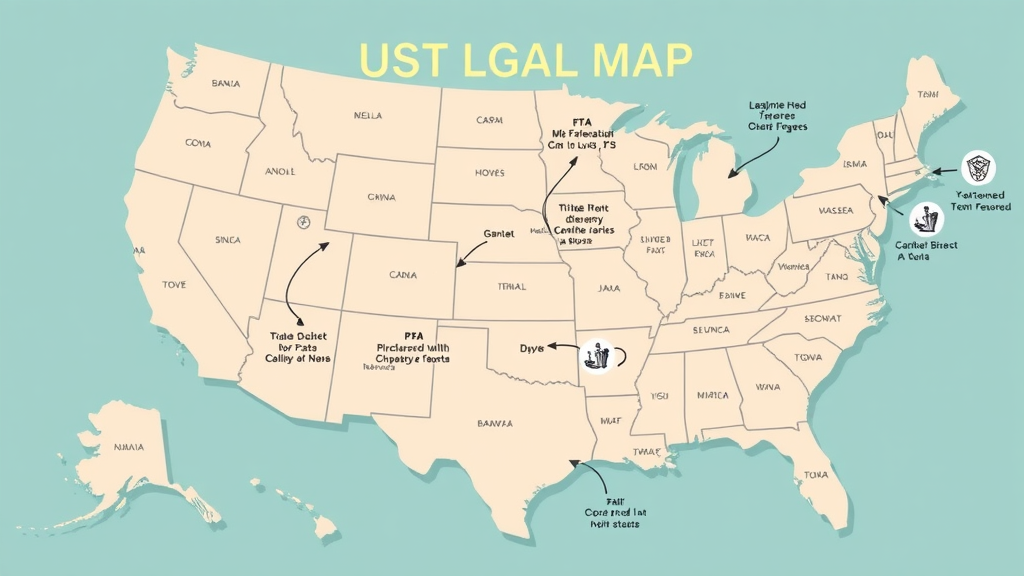Did you know: Over 95% of personal injury cases are settled before reaching trial? This surprising statistic underscores the importance of understanding each stage in the personal injury legal process —from initial consultation with an injury attorney to the final settlement offer. Whether you’re an injured party, anxious about medical bills after a car accident, or simply want to ensure your rights are protected, knowing how injury laws work is your best defense and your strongest asset.
Understanding the Personal Injury Legal Process: Surprising Facts You Need to Know
The personal injury legal process can seem complex, but it’s designed to ensure that victims of accidents and injuries have a fair path to compensation. Many people assume that every injury case will inevitably go to trial; however, statistics reveal that most personal injury claims are resolved long before a judge ever hears them. This means the negotiation and documentation stages are often just as crucial as any courtroom drama. Armed with the right knowledge, an injured party can better navigate settlement offers from the insurance company and understand the value of having an experienced law firm on their side.
Personal injury law encompasses a broad spectrum of cases, including car accidents, slip and falls, medical malpractice, and product liability. These laws help ensure that individuals harmed due to someone else’s negligence can seek monetary recovery for damages like medical expenses, lost wages, and pain and suffering. By diving deep into the intricacies of injury lawsuits—from statutes of limitations to demand letters and evidence—this guide ensures you’re equipped to tackle every stage of the process confidently and effectively.

Image: Informative courthouse exterior with dignified atmosphere, representing the seriousness and formality of the personal injury legal process.
Personal Injury Legal Process Overview
- Defining personal injury and the personal injury legal process: Personal injury cases revolve around disputes where one party has been physically or emotionally injured due to another’s negligence or intentional actions. The process includes everything from the initial injury event through claim resolution or trial.
- Significance of personal injury laws in your injury case: These laws empower victims by offering legal avenues to claim compensation for their losses and hold responsible parties accountable for damages sustained in injury cases.
- Common misconceptions about injury law and injury cases: Many believe only serious injuries qualify for compensation or that an insurance company’s first settlement offer is always fair. In reality, even minor injuries can be grounds for a claim, and legal representation often results in larger settlements.
A well-informed understanding of injury law and common pitfalls in injury cases is essential. Don’t underestimate the value of preparation and the power of a strong law firm. Navigating this process typically begins with seeking a free consultation from an injury lawyer or law firm, ensuring your path to recovery is protected from the outset.
How Personal Injury Law Applies to Your Injury Case
At its core, personal injury law establishes the legal parameters for determining liability and securing compensation for the injured party . Whether your case stems from a car accident, workplace injury, or a slip-and-fall incident, these injury laws define what constitutes negligence, causation, and damages. Personal injury lawyers know the ins and outs of these statutes, helping clients navigate the maze of injury claims and injury lawsuits to secure rightful compensation.
Your personal injury case will rest heavily on demonstrating a clear breach of duty, establishing the direct cause of your injuries, and substantiating the extent of your losses. Each element must be meticulously documented to withstand scrutiny from the insurance company or the opposing law firm. Personal injury law’s scope covers everything from minor property damage to life-altering catastrophic injuries, and understanding these distinctions early on helps shape the best strategy for your claim.
Personal Injury Laws: Statutes, Types, and Scope
- Different types of personal injury cases: Personal injury law covers a vast range of injury cases, including car accidents, workplace incidents, medical malpractice, defective products, and more.
- How injury laws impact your personal injury claim: The type of injury case determines which legal statutes apply, what evidence is needed, and which deadlines must be followed. Injury laws outline the procedures for proving liability, calculating damages, and seeking justice in personal injury lawsuits.
Recognizing the types and scope of injury laws means you can tailor your documentation and negotiation strategies for your specific injury case. A timely free consultation with a personal injury lawyer ensures your approach is customized and compliant with all relevant statutes.

Image: Orderly legal office workspace, representing a thoughtful attorney reviewing case files—an essential step in every personal injury case.
What You'll Learn About the Personal Injury Legal Process
- Every stage of the personal injury legal process fully explained
- Key statutes and deadlines for filing your personal injury case
- What steps to take after suffering a personal injury
- How to work effectively with a personal injury lawyer and law firm
By the end of this guide, you'll have a solid understanding of how to start and successfully resolve an injury claim. You'll discover why acting quickly is critical, how to document evidence, what to expect from negotiations with the insurance company, and why the experience of your law firm is often the most important factor in your case outcome.
Step-by-Step Breakdown: How a Personal Injury Claim Works
The personal injury legal process unfolds in several well-defined phases. Each has its own rules, best practices, and potential pitfalls. From the initial consultation with a personal injury attorney to the possibility of filing a lawsuit, every step should be handled with careful attention to detail to maximize compensation for the injured party. Consulting with an injury lawyer early helps secure valuable evidence, assess injuries, and build a persuasive case before negotiating with the insurance company.
The following sections describe each critical stage, what to expect, and how to position yourself for the best outcome—whether you settle or proceed to a personal injury lawsuit. Understanding the flow and timing can alleviate anxiety and help you work in harmony with your law firm.
Initial Consultation with a Personal Injury Lawyer or Attorney
- What to bring to your free consultation: Be prepared with accident reports, medical records, photographs, witness information, and any communication with the insurance company. This gives your injury attorney a comprehensive view of your potential injury case and aids in strategic planning from the start.
- Questions to ask your injury attorney: Don’t hesitate to ask about the law firm’s experience with injury law, their success rate with similar injury cases, and how they handle communication and fees. Understanding their process and comfort with going to trial can make a significant difference as your case progresses.
That initial meeting sets expectations and allows your lawyer to assess liability and damages. Remember, the best law firm will not only know the legal ropes but also treat you like a partner in your personal injury claim, walking you through each next step.
Case Evaluation and Retainer Agreements
- Reviewing medical treatment records and evidence: Your injury lawyer closely examines all documentation, including medical records, accident details, witness statements, and cost logs to accurately value your personal injury claim.
- How injury lawyers assess liability and damages: Lawyers use legal precedents, statutes, and case facts to determine the strength of your claim and potential compensation. This assessment forms the foundation of your case strategy and negotiation leverage with the insurance company.
A transparent retainer agreement spells out responsibilities between you and your law firm, clarifying payment terms and ensuring both parties are committed to advancing the injury case efficiently.
Demand Letter and Negotiations with the Insurance Company
- Drafting a compelling demand letter: Your personal injury attorney crafts a detailed demand letter, outlining the extent of your injuries, medical costs, lost wages, and other damages, and formally demands compensation from the insurance company.
- Responding to a settlement offer from the insurance company: The law firm and client together evaluate the initial settlement offer, considering whether it fully addresses current and future losses. Strategic negotiation often yields better outcomes, but your lawyer’s advice is key when deciding to accept or seek more.
This phase is where most personal injury claims are resolved. Strong negotiation backed by solid injury law expertise can lead to a swift settlement, while weak documentation or passive tactics may invite lower offers.
Settlement or Proceeding to Personal Injury Lawsuit
- When to settle your injury claim: A settlement is recommended when a fair compensation amount is agreed upon. The decision should consider all short- and long-term impacts of your injuries, not just immediate medical bills.
- What happens if a lawsuit is filed: If compromise cannot be reached, your law firm files a personal injury lawsuit. The case then moves into litigation, with discovery, pre-trial meetings, and ultimately, a trial or arbitration to resolve the injury case in court.
Choosing whether to settle or pursue litigation is a major crossroads, guided by your lawyer’s assessment of injury laws, the insurance company’s position, and the overall strength of your evidence.

Image: Focused injury attorney explaining the process to a client, reinforcing the importance of clear guidance throughout the personal injury legal process.
Statute of Limitations: Time Limits in Personal Injury Laws
- State-specific statutes of limitations: Each state has its statute of limitations, strictly limiting the time to file a personal injury lawsuit. For instance, many states enforce a two- or three-year deadline post-injury, and missing this window voids your right to claim.
- Exceptions and extensions in personal injury law: Some circumstances, such as a delayed discovery of injuries or claims involving minors, may extend the allowable filing period. An experienced injury lawyer can clarify if any exceptions apply to your case.
Understanding how the statute of limitations applies to your personal injury case is critical. Delaying action can irreversibly harm your chances of recovering compensation, making early legal consultation essential for all injury cases.
Medical Treatment and Its Role in the Personal Injury Legal Process
- Documenting your injuries for your personal injury claim: Consistently seeking and recording medical treatment is foundational to your case. Medical records serve as the primary evidence for proving the extent of your injuries and the necessity of ongoing care.
- How medical treatment influences your injury case outcome: Immediate and continued care demonstrates both the seriousness and causation of your injuries. Gaps in medical treatment can jeopardize the credibility of your injury claim and reduce your ultimate compensation.
Your lawyer will often recommend keeping a detailed log of doctor visits, prescriptions, therapies, and costs. Complete medical documentation is often the deciding factor that drives successful settlement offers or wins in court.

Image: Compassionate doctor and patient discussing injuries—medical documentation is crucial in every stage of the personal injury legal process.
Personal Injury Settlements and Negotiation Tactics
- How settlement offers are calculated in personal injury cases: The offer usually incorporates medical expenses, lost wages, pain and suffering, property damage, and future costs. Injury law, state caps, and the insurance company’s assessment all factor into the final number.
- When to accept or reject a settlement offer from the insurance company: Professionals advise that you only accept an offer after consulting with your law firm. Settlements become final once signed, so ensuring the compensation truly covers all injury-related costs is imperative before agreeing.
Well-prepared documentation and skilled negotiation can pressure the insurance company into better settlement offers—sometimes making the difference between a swift resolution and a protracted injury lawsuit.
| Step | Description |
|---|---|
| Initial Consultation | Meet with a personal injury lawyer to discuss your injury case |
| Investigation | Attorney and law firm gather evidence and assess liability |
| Demand Letter | Lawyer submits claim to the insurance company |
| Negotiation | Discussions to reach a fair settlement offer |
| Filing Lawsuit | If negotiations fail, your lawyer files a personal injury lawsuit |
| Discovery | Both sides exchange evidence |
| Trial | Final arguments and decision by judge or jury |
"A great personal injury attorney does more than argue in court; they guide you through every step, ensuring your rights are protected and maximizing your compensation." – Renowned Injury Law Expert
Key Individuals Involved in the Personal Injury Legal Process
- The injured party and their personal injury attorney
- The injury lawyer and law firm representing your interests
- The insurance company and their defense lawyer
Each party holds specialized responsibilities. The injured party provides evidence and follows medical advice. The personal injury lawyer organizes, documents, and negotiates on your behalf. Law firms bring depth and support, leveraging legal staff and resources. The insurance company (often adversarial) assesses, challenges, or disputes the injury claim, generally seeking to minimize their payout. Recognizing these roles helps demystify the process and clarify who is advocating for your best outcome.

Image: Diverse group of legal professionals collaborating—highlighting the roles of attorneys, insurance professionals, and clients in a personal injury case.
The Role of Evidence and Documentation in Injury Lawsuits
- Medical records and treatment documents
- Witness statements and photographs
- Cost logs for expenses during your injury case
Evidence is the foundation of every successful personal injury lawsuit. Medical records substantiate the extent of your injuries. Witness statements and photos support your version of events, while cost logs account for every dollar lost or spent during recovery. Injury attorneys often use detailed evidence packages to counter insurance company defenses and to support a favorable demand letter or trial presentation.
Insufficient evidence can jeopardize your compensation, so gathering documentation from the moment of injury is non-negotiable. Your law firm’s support in assembling, preserving, and presenting this information can make or break your injury case.
Watch a comprehensive animated explainer featuring legal graphics, flowcharts, and interviews with experienced personal injury attorneys walking you through every stage of a personal injury case—from initial consultation to settlement, with quick call-out overlays for essential tips.
Filing a Personal Injury Lawsuit: What to Expect
When negotiation doesn’t result in a fair settlement offer, you may need to file a lawsuit . The next steps transition your claim into formal litigation, with new requirements and deadlines. Understanding the process ahead can reduce stress and help you work more effectively with your law firm.
How a Lawsuit Is Filed and Served
- The formal process of commencing an injury lawsuit: Your lawyer will draft and file a complaint with the court, clearly laying out your injury case, damages, and requested relief. The defendant is then formally served with a summons and complaint, triggering their obligation to respond.
- Key deadlines and documentation: The statute of limitations governs the absolute latest date you can file. You must also submit initial disclosures, witness lists, and all supporting documentation within strict court timelines.
Meticulous compliance with filing procedures and deadlines is vital. Errors or missed deadlines can lead to dismissals or lost claims—another reason why experienced representation is invaluable in injury lawsuits.
The Phases of a Personal Injury Lawsuit
- Discovery and negotiations in injury law terms: Both sides exchange evidence, answer written questions (interrogatories), and take depositions from witnesses to clarify the facts and attempt further settlement negotiations.
- Pre-trial and trial stages explained: In the pre-trial phase, motions are heard, settlement conferences occur, and trial logistics are set. If the case proceeds, the injury lawsuit is presented in front of a judge or jury for final resolution.
Understanding these phases prepares you for the reality that legal processes take time, but persistence and organized evidence can greatly influence the outcome of your personal injury lawsuit.
Comparing Injury Laws: State Variations and Their Impact
Injury laws differ significantly by state. These variations impact how liability is determined, who is eligible for compensation, and what procedural steps must be taken. Thoroughly reviewing your state’s statutes—ideally with a qualified injury attorney or law firm—prevents costly errors.
| State | Statute of Limitations | Notable Laws |
|---|---|---|
| California | 2 Years | Pure Comparative Negligence |
| New York | 3 Years | No-Fault for Car Accidents |
| Texas | 2 Years | Modified Comparative Fault |

Image: US legal map highlighting differences in personal injury laws, statute of limitations, and negligence standards.
How to Choose a Personal Injury Lawyer or Law Firm
- Criteria for selecting a personal injury attorney: Look for firms with deep experience in injury law and a proven track record of success in similar cases. Knowledge of local statutes and court systems is key.
- Importance of free consultation offers: Take advantage of free consultations to ask about case assessment, strategy, fees, and communication. This initial interaction reveals much about the law firm’s approach and expertise.
- Evaluating law firm experience in injury law: Ask about prior personal injury lawsuits, trial experience, and historical settlement results. Trust, transparency, and strong client testimonials are strong indicators of a top-tier law firm.
Carefully choosing representation can directly impact your results. The best injury attorneys combine legal insight, negotiation skill, and compassionate advocacy throughout the entire personal injury legal process.

Image: Welcoming personal injury lawyer ready to offer free consultation—your first step in selecting the right law firm for your injury claim.
FAQs About the Personal Injury Legal Process
- How long does a personal injury lawsuit take? The timeline varies widely, from a few months to several years, depending on the complexity of the case, severity of injuries, willingness of the insurance company to negotiate, and whether the case goes to trial. Working with an experienced law firm can expedite the process while ensuring thorough preparation.
- What compensation is available for injury cases? Compensation often includes medical bills, lost wages, pain and suffering, future medical costs, and sometimes punitive damages. Each personal injury case is unique, with total recovery shaped by the strength of evidence, compliance with injury laws, and the negotiation skills of your lawyer.
- Will your case go to trial? Most personal injury lawsuits settle before trial, but a small percentage do proceed to court. If settlement negotiations stall, your attorney will prepare your injury lawsuit for trial to pursue a fair verdict.
People Also Ask: What not to say to an injury lawyer?
While honesty is critical, avoid saying things that speculate about fault or minimize your injuries ("It was probably my fault" or "I feel fine now"). Stick to facts, avoid guessing, and never provide unverified information. Disclosing every detail to your injury attorney enables them to build the strongest possible case, but admissions of fault or inconsistencies could inadvertently weaken your personal injury claim.

Image: Careful attorney-client discussion—factual accuracy is crucial when assisting your law firm in building a strong case.
People Also Ask: How hard is it to win a personal injury lawsuit?
Winning a personal injury lawsuit depends on the quality of evidence, credibility of medical records, and your law firm’s ability to prove liability. Skilled attorneys can overcome even challenging opposition, but cases with little documentation or unclear injury laws may be difficult. Settling before trial is often preferred when the path to victory is uncertain.
People Also Ask: What is the average payout for personal injury?
The average payout for a personal injury claim varies—from several thousand to millions—based on injury severity, jurisdiction, and applicable injury laws. Medical costs, lost income, pain and suffering, and the skill of your personal injury lawyer all play significant roles in settlement values.
People Also Ask: What is the burden of proof for personal injury?
In a personal injury lawsuit, the burden of proof is typically "preponderance of evidence." This means your law firm must show it’s more likely than not that the defendant’s negligence caused your injuries. Documentation, witness accounts, and expert testimony help meet this standard and secure compensation for the injured party.
Explore an animated documentary with real-life plaintiff and lawyer interviews, highlighting what made the difference in both successful and unsuccessful personal injury lawsuits. Learn actionable tips for every stage of your own case.
Dive into behind-the-scenes insurance industry tactics with legal commentary and reenactments. Understand how companies assess injury claims, manage investigations, and negotiate settlement offers—key knowledge for any injured party.
Injury Laws and Case Precedents: Learning from Past Personal Injury Lawsuits
- Key case studies and outcomes in personal injury law: Reviewing similar injury cases and their outcomes can clarify what to expect and guide your legal team in strategy and settlement negotiations.
- How legal precedents can influence your personal injury case: Judges and juries rely on past decisions to shape new rulings. Familiarity with relevant precedent can strengthen your personal injury lawsuit and empower your law firm to argue more persuasively.
Consulting with a seasoned injury lawyer ensures your case aligns with established legal standards, maximizing your odds of favorable compensation.
Key Takeaways for Navigating the Personal Injury Legal Process
- Timely action is critical due to statute of limitations
- Document everything for your injury claim
- Choose an experienced injury lawyer or law firm for your personal injury lawsuit
These steps boost your chances of securing fair compensation, shielding you from procedural errors and helping achieve justice in your personal injury legal process .
Next Steps in Your Personal Injury Legal Process Journey
Be proactive—consult a personal injury lawyer, gather documentation, and act before your statute of limitations expires. The right actions today create a stronger, smoother legal path. Learn more: visit pugetsoundinjurylaw.com
Understanding the personal injury legal process is crucial for anyone seeking compensation after an accident. To deepen your knowledge, consider exploring the following resources:
-
“The 10 Steps of a Personal Injury Lawsuit” : This article provides a comprehensive overview of each phase in a personal injury case, from initial consultation to trial proceedings. ( superlawyers.com )
-
“Personal Injury Lawsuit Process | Tracey Fox & Walters, Texas” : This resource outlines the key stages of a personal injury lawsuit, including filing deadlines and the discovery process. ( traceylawfirm.com )
These resources offer valuable insights into the personal injury legal process, helping you navigate your case with confidence.
 Add Row
Add Row  Add
Add 




Write A Comment